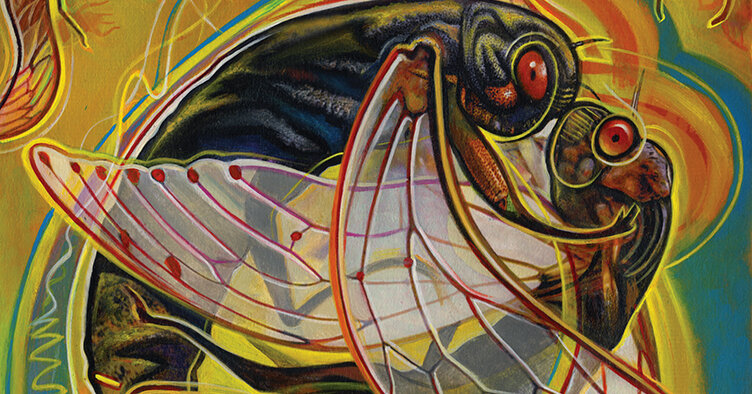The moment has arrived.
After years underground, periodical cicadas — insects of the genus Magicicada — are emerging by the trillions across more than a dozen states to molt, sing, court and mate. A casual human listener could mistake their collective chorus for the sound of a U.F.O. landing:
But to the individual cicada, what’s underway is a courtship ritual as intimate and intricate as a tango. The stakes are high; the potential missteps are many.
Review the guest list
This year, in a rare “dual emergence,” two groups of periodical cicadas are in attendance: Brood XIII, or the Northern Illinois Brood, comprising as many as three species of 17-year cicada in some locations, and Brood XIX, the Great Southern Brood, comprising up to four species of 13-year cicada. Their songs — like those of Magicicada septendecim and Magicicada neotredecim, below — can sound deceptively similar:
Arrive early(ish)
Female cicadas typically mate just once, so it behooves the male to emerge early — hence the mad rush from the soil to the treetops. But don’t be too early: The first cicadas over the top are ripe for slaughter, when “everything is hungry and predators discover that they’re the best thing to eat,” said David Marshall, a biologist and expert on periodical cicadas.
The odds of reproducing improve in the second wave, once what ecologists call “predator satiation” has set in. “You want to be Johnny on the spot,” Dr. Marshall said. “And if you show up late, you’re really screwing up.”
Get naked
After emerging, you may need several days to adjust to life aboveground. Right away you’ll molt, squeezing out of your nymph exoskeleton and unfurling your wings; slowly you’ll solidify and turn a glossy black. Soon enough, when the air turns warm and the sun is bright, it will be time for the males to sing.
Rattle your tymbals
The male cicada is an amplified beer can. The abdomen is hollow, and on either side is a membrane called a tymbal, not unlike a woofer: Vibrate it, and the sound broadcasts. To change the frequency, alter the shape and position of the abdomen.
Sing a little, fly a little
Courtship proceeds in roughly three phases, each with an associated song specific to a particular species. Initially, the male sings a brief, inviting phrase a couple of times, flies a foot or two, lands and sings again. “He’s acoustically trolling for receptive females,” Dr. Marshall said. The song of M. tredecim, a trill that bends into what scientists call a downslur as the male arcs his abdomen downward, sounds like an inverted question mark: bzzz-ewwwww.
Stop, look, listen
Most females will be unreceptive to male advances; either they have already mated or are not yet physiologically ready. Males, be on the lookout for subtle wing flicks, the little shrugs of potential interest. Eventually these become loud, obvious snaps of her wings.
Meanwhile, beware the buttinsky that lands nearby. Competing males can produce an interference buzz, like this one by M. tredecim: a slurred version of the invitational phrase, which jams the first male’s call, makes the female ignore him and prompts him to fly off, discouraged.
Now get closer
If the female expresses interest — if she snaps her wings within about a half-second of the male’s invitation — the male should approach and switch to the next song. This resembles the first song but comes in a rapid series with no gaps between phrases.
Business time
Until this moment it’s been hands- and legs-off, but now the male may reach out and gingerly touch the female, perhaps near the eye, as he switches to his last song, a series of staccato notes. Let the actual mating commence (and give it three to five hours to conclude).
Through all of this, the female has one job, Dr. Marshall notes: “Don’t mate with the wrong species.” With a variety of beer cans clattering all around, maybe transmitting a song physically is a good, final way of reassuring the female that she has picked the right brand.
Oh, and avoid the zombies!
As cicadas first burrow up through the soil, some will encounter the spores of Massospora cicadina, a fungus that turns cicadas into sex-crazed, spore-filled zombies intent on mating and spreading the infection. Woe unto the deceived, Dr. Marshall said: “He’ll become a hapless spore-spreader for the next generation.”
A happy ending
In four to six weeks it will all be over, the dance floor littered with spent cicada carcasses, the air stinking of decay — and the trees bearing small nests of cicada eggs. In another six to 10 weeks the eggs will hatch and the tiny nymphs will drop to the ground, burrow down, find a rootlet to sip on, and wait. See you in 13 or 17 years!
